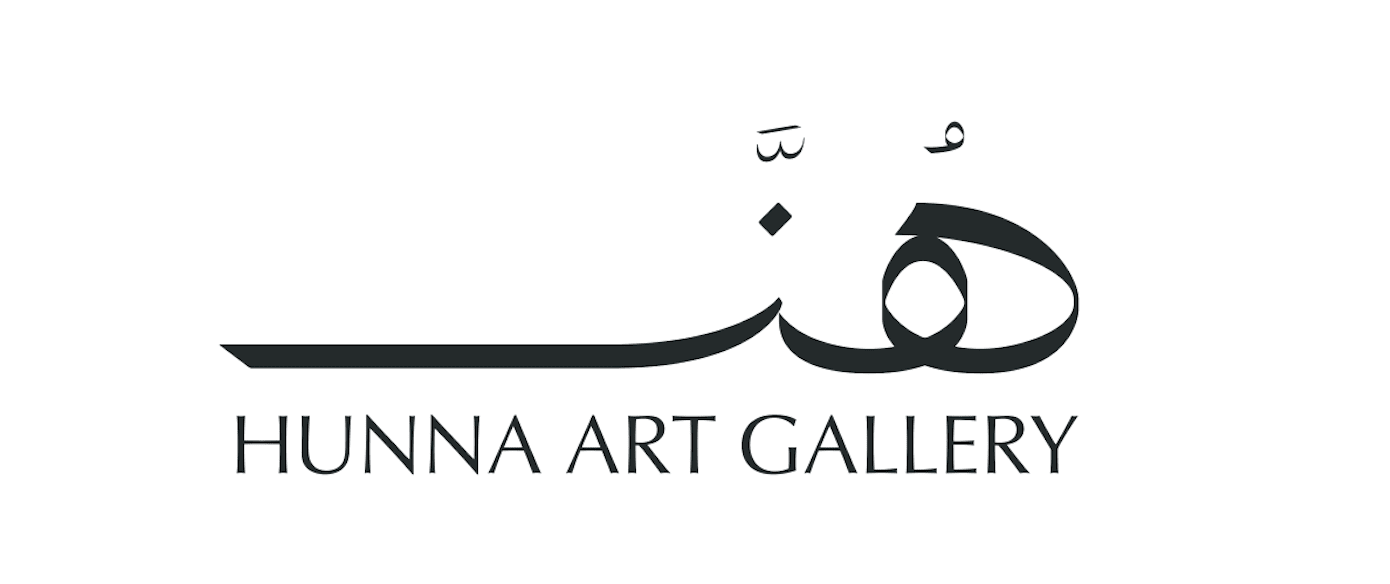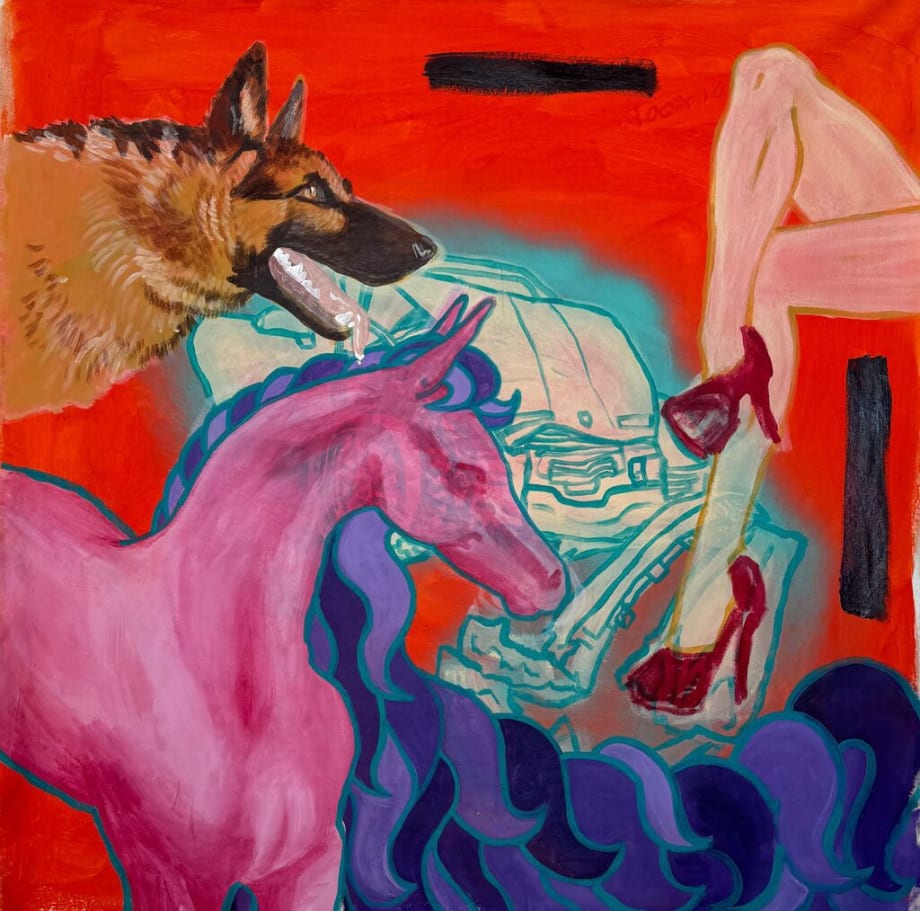Almoayyed came to life on an island of broken dreams, where the starry-eyed optimism of the generation that preceded her were extinguished by the harsh realities of the region. These hushed realities are caught in the bristles of her brush; the silent echoes of pain, the keening from decades past, a society that has become docile and complacent in its own failings and one that makes truth invisible. Her artwork is dripped with defiance and reflects to her audience a glaring view of her world. They are a war cry that beckons for self-reflection and atonement from draconian societal norms.
Almoayyed first display of her therianthropic figures were 2012 - 2013 series “Desperate Times Call For Desperate Measures”. She captivated her audience with these initial portrayals of hybrid human-animal figures that stare back at the viewer with undeniable rebellion. A ram's head on top of a naked female torso is violently confrontational and an obvious response to the abrasive patriarchal structures and the heavy burden of being female in her environment. Each aspect of her work carries an avid anger and vexation, which not only represents her own experiences but is a testimony of the injustices she sees around her. In this series Almoayyed depicts sentiments that are usually relegated to whispers behind closed doors. Her hybrid creatures took it upon themselves to refuse subtlety and take arms against the male gaze. Her figures do not ask for permission to belong and neither does she.
Further to aforementioned artworks, we are introduced to an extension of this series which was showcased as part of the group exhibition “In the Open,” at Edge of Arabia’s gallery formerly located in Battersea. Almoayyed displayed her potato heads and “She’s A Bitch”, which portrays the female experience in macabre distortion. In this exhibition, she playfully satirized the gender discrepancies invoked in her previous works. The volcanic anger seen in her previous work is sieved to show potato-like beings and a posturing dog staring out of the canvas in a sorrowful gaze. The latter, aptly dubbed, “She’s a Bitch” is more than a play on words. This work brings to the forefront the potent shame a woman experiences by being from the Arabian Gulf. In the Gulf region, women are subject to different rules than their male counterparts. They are coerced by their parents laws and expectations until they succumb to the institution of marriage. Queerness is quashed under a blanket of secrecy and abject denial. There is an obfuscation when it comes to these rules. They are coated with dense layers of guilt, so much that the reaction is to fear any form of self-expression or self-respect. Articulating personal truths are concealed by trepidation that you will be dishonor your family, friends and the people you love.
It is the mind-numbing fear that you will be exiled by voicing the proverbial whispers. Borrowing a few lines from Saleem Al Haddad’s debut novel Guapa, she explains this personal struggles: “My culture was complex and different. Our installs were not a lack of commitment, they were a recognition that rules and regulations can only get you so far… I didn’t despise my shame. I had no reason to do so. My shame illuminated my intense attachment to the world, my desire to be connected by others.”
Almoayyed next noteworthy showcase further underscores these points in her Goldsmiths Graduate Exhibition at in 2014. Still provocative, her artistic language has taken a stronger form. It is true, to surmise that themes of anger and shame have found themselves in her graduating exhibition, but the tone of the narrative has changed. The raw anger in her previous work has been diluted into meditative commentary.
This is exemplified by her rat sculpture made up of cement casts of rats flattened into square boxes. These miniature sculptures of rats were stacked on each other in a formation that ran down the wall and onto the floor, making one’s skin crawl as if the rats would come to life and consume all that was around them. The effect, to say the least, is jarring. The rats were a plague, they represented a vulgar infestation. It categorized Almoayyed views on hypocrisy and the lack of. The image of the rats forced into a box like shape, correlates with the message that individuals hailing from the Gulf live a wretched existence where they resolve to contort themselves into unnatural shapes just to survive. Ironically, a small part of rat sculpture, was submitted to the 41st Annual Art Exhibition at the Bahrain National Museum in 2015 won first place for the Dana Prize. It was as if the Bahraini society were acknowledging what she has been emoting in her work all along.
Almoayyed presented a life size contorted anthropomorphic human animal sculpture for her Final Degree Show Exhibition at Goldsmiths University. Complimenting her sculpture were a series of car crashes depicted with ink on paper. ‘‘Swipe Clean’’. Each one shows a deformed car usually shown standing, some are with expletives decorating their background and one other is of a woman donning an abaya, flirtatiously exposing a bare leg with stockings. There is so much to unpack with these images. For one, car crashes are a common place amongst youth culture in the Gulf region, Bahrain’s small main island is paved with short and narrow roads often the scene of car crashes that Aysha depicts. However, it takes a trained eye to look more closely at these tragic depictions, and find that Almoayyed is mirroring the automobile culture in her native country. Consequently, her depiction of car crashes act as an allegory for the auto-mobile culture prevalent in Gulf countries. Born perhaps out of boredom and existential angst, the youth culture in the region devotes itself to cars for many reasons.
Namely, that the first taste of freedom from familial and societal norms is the moment when one turns eighteen and is offered a small piece of plastic in the form of a driver’s licence. The keys to an automobile then becomes the only space to escape the expectations of society. It becomes the mobile apartment you can have before marriage, it becomes the vessel in which you can be and become yourself. Moreover, there is an intense sense of pride with one's car, it goes one step further to make the licence plate act like family sigils. Since they are numerical up to six-digits, number plates are memorized and allotted to different families. It is both a way to be watched and a way to mark one’s territory. The car is now not only a vehicle but also is the extension of the individuals identity for the first time. In a culture that can breath only under the veil of secrecy, Almoayyed’s work holds up a mirror to people who are blindly complicit to a problematic culture. This automobile culture has birthed toxic masculinity, men chasing women by car until they can illicit some kind of communication. In fact, slang for two people dating in the country is “they speak with each other.” There is a reason why the car is crashing, it eludes the behavior that has come from the counter-culture and a deterioration of the common decency in a society that boasts religious and societal moral high-ground.
Almoayyed is not the only person to recognize these societal pitfalls. Sophia Al Maria, the doyenne of Gulf-futurism, describes the current climate in the Gulf as reflecting the dominant class concerned with master-planning and world-building, while the youth culture is preoccupied with fast cars, fast tech and viddying a bit of ultra-violence. There is an advent disparity between societal expectations and the action of said society. Almoayyed’s artistic practice is centered around the relationship of Gulf inhabitants and their relationship to their self-imposed social constructs. She showcases this concept in her work by highlighting how automobiles and mobile phones are used as dysfunctional objects. Mobile phones have been vital instruments in facilitating underground connections since the bluetooth was introduced to mobile phones in the nineties. A person could walk into a crowded coffee shop or any other proverbial watering hole and turn on their bluetooth. This makes them automatically discoverable within a three meter radius under a fictional handle keeping their reputation intact.
Fast forward to 2017, Almoayyed joined #extrange, an e-bay intervention curated by Stamps School of Art & Design Associate Professor Rebekah Modrak and Marialaura Ghidini from the Srishti Institute of Art, Design & Technology. Her intervention was alongside Nasser Al Zayani and Jenine Sharabi under the theme of “Other things”. For this project artists were chosen to challenge the farcical and often myopic view of the Gulf States, by encapsulating moments that aren’t often shared. Here, Almoayyed took it upon herself to pass the threshold from the alternate reality her artwork creates into activism and social commentary. Her focus for the e-bay intervention was societal gossip that consumes small societies like hers. She chose to shed light on an actual incident that occurred on December 24, 2016, in the Kingdom of Bahrain and how the society dealt with it. the description of her e-bay page read: “The work is a website consisting of random peoples’ accounts of the incident. None of these people were eyewitnesses or credible sources. It is a collection of what was being discussed after Eman El Salahi’s death. If you purchase the work, you will gain access to a website, containing a collection of stories that have been circulating since her murder." By scrolling the website, you will find screenshots collected from conversations about the incident, evidence of “fake news” when the local newspaper depicted the wrong people associated with the crime and most notably a voice recording of the woman who’s photo the mentioned newspaper used to portray the murder victim. The voice clip was shared on a twitter profile beseeching people to not believe the newspapers and that she hasn’t been harmed. This work added to the portfolio of observations of a society with shaky foundations.
At this stage of Almoayyed’s career, a common denominator can easily be seen. She creates pieces of work that toe the line between reality and the absurd. Her work acts in direct response to her surroundings, especially her condemnation of gender and societal restrictions in Gulf culture. Her work dallies between a banging urgency and tongue-in-cheek satire; when approaching her work one doesn’t know whether to laugh or cry. Her unique style of holding her observations into her work is distinctive. Her varying artistic language still tells the same story. In her latest endeavor, “5alid called and he’ll call again :)”. The blank ink and animal sculptures are replaced with neon depicting a flirtatious quote, a sculpture crashed car spray-painted in custom florid colours and neon. The sculpture depicts an image common to the women residing in the Arabian Gulf, it represents the malaise of attending funerals for those who perish in such accidents most before the age of twenty, and the quixotic underground counter-culture that against societal norms. Her artwork no longer lives in the realm of allegory but instead reality is her paintbrush. Her latest series create a caricature of the designer-clad, tech-savvy, Gulf national, who are instagram obsessed, hash-tagging, snap-chatting, blind consumers of cultures that aren’t even theirs. It pokes at an inside joke that only a few could relate to. It smiles at the fact we are all together in a revolution that exist in DM’s, behind closed doors and behind the tinted glass of European cars.


